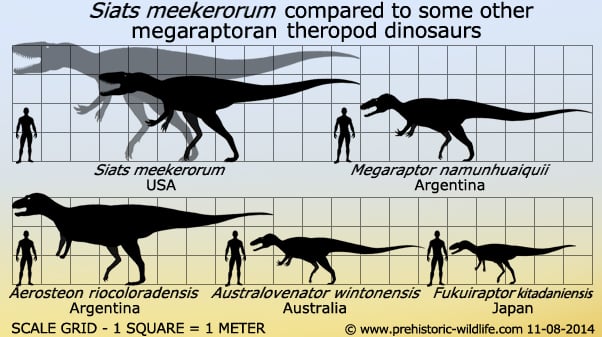Paleontologists announced today the discovery of a new predatory dinosaur that lived in what is modern-day Utah around 100 million years ago.

An artist’s reconstruction of Siats meekerorum. Image credit: Jorge Gonzales.
“This dinosaur was a colossal predator second only to the great Tyrannosaurus rex and perhaps Acrocanthosaurus in the North American fossil record,” said Dr Lindsay Zanno from the North Carolina Museum of Natural Sciences and the Field Museum of Natural History, the lead author on the paper published in the journal Nature Communications.
The prehistoric giant is named Siats meekerorum. The genus name, Siats, refers to a cannibalistic monster from the mythology of the Ute Native American people. Its specific name acknowledges the Meeker family for their support for early career paleontologists at the Field Museum.

Siats meekerorum was over 9 meters long and weighed more than 4 tons. Despite its large size, the dinosaur is not a close relative of Tyrannosaurus rex and other tyrannosaurs. Rather, it belongs to the carcharodontosaurian group of theropods, whose more famous members include giants like the Argentinean Giganotosaurus. Siats meekerorum belongs to a branch of the carcharodontosaurian family tree that was previously unknown in North America.
“We were thrilled to discover the first dinosaur of its kind in North America and add to mounting evidence that dinosaurs were widely dispersed across the globe 100 million years ago” said Dr Peter Makovicky of the Field Museum of Natural History, who is a co-author of the discovery paper.

Siats meekerorum comes from the middle of a 30-million-year gap in the fossil record of North American large predatory dinosaurs, during which the top predator role changed hands from carcharodontodsaurians in the Early Cretaceous to tyrannosaurs in the Late Cretaceous.
The lack of fossils left paleontologists unsure about when this change happened and if tyrannosaurus outcompeted carcharodontosaurs, or assumed that niche following carcharodontosaur extinction. The upper Cedar Mountain Formation is currently one of the only rock units known to produce fossils of both groups.

Teeth of tyrannosaurs from the Cedar Mountain Formation indicate that the tyrannosaurs living alongside Siats meekerorum were much smaller in stature and did not compete for the apex predator role.
“The huge size difference certainly suggests that tyrannosaurs were held in check by carcharodontosaurs, and only evolved into enormous apex predators after the carcharodontosaurs disappeared,” Dr Makovicky said.

“Finding Siats in the 30-million-year predator gap tells us carcharodontosaurians reigned supreme in North America for much longer than anyone had expected,” Dr Zanno added.
Until recently, it was thought that continental rifting in the Cretaceous caused isolation between dinosaur faunas on different continents, and the early-to- middle Cretaceous faunas of North America were particularly isolated. That picture is rapidly changing through discoveries such as Siats meekerorum.
Source: sci.news








